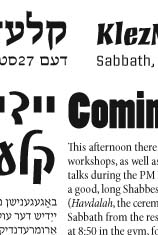Just a short notice of a week of solid fun up at KlezKanada, a week-long annual gathering of Yiddish culture buffs at Camp Bnai Brith, about an hour north of Montreal.
 First, I borrowed a set of huge wooden type letters from the National Yiddish Book Center. Big, major fun.
First, I borrowed a set of huge wooden type letters from the National Yiddish Book Center. Big, major fun.
 The letters were actually used in artwork created by the Visual Arts program. That program featured Emily Socolov, Vera Sokolow, and the Montreal calligrapher Jamie Shear. I was supposed to be part of it, but other than giving a slide show about Hebrew typography, I was totally distracted by the newsletter.
The letters were actually used in artwork created by the Visual Arts program. That program featured Emily Socolov, Vera Sokolow, and the Montreal calligrapher Jamie Shear. I was supposed to be part of it, but other than giving a slide show about Hebrew typography, I was totally distracted by the newsletter.
 The big fun was the newsletter. In format, it tried to be a sort of Junior High School paper—lots of loud type and graphics, lots of articles written by KlezKanada participants, and especially, a chance to present English, Russian, French, Spanish, and Yiddish with ease. I especially wanted people to see lots and lots of Hebrew that wasn't Frank Rühl or those horrible late 19th century van Dijk-influenced fonts that we grew up with. That was the special part.
The big fun was the newsletter. In format, it tried to be a sort of Junior High School paper—lots of loud type and graphics, lots of articles written by KlezKanada participants, and especially, a chance to present English, Russian, French, Spanish, and Yiddish with ease. I especially wanted people to see lots and lots of Hebrew that wasn't Frank Rühl or those horrible late 19th century van Dijk-influenced fonts that we grew up with. That was the special part.
What made it all work was the combination of Word and InDesign ME. People would type their material on their own computers using whatever (most often Word, but I saw everything from AppleWorks to unknown). So long as Word could recognize the encoding—and in this instance, it always did—it could convert everyone's files to its native Unicode format. Once saved, I could easily place the files in InDesign ME. Layout was a breeze. If you pay attention to the KlezmerShack over the next days you'll see the newsletters go online and you'll find everything from song lyrics in three columns (Yiddish - transliteration - English, per my preferred style) to MadLibs and wild stuff. InDesign didn't care. I have never had to pay less attention to the tool while doing layout. Every day I had from after breakfast (about 9am) until about 11:30 to get all of the material copied, edited, the photos edited, and the whole thing laid out. As the week went on and we went from four pages to six to eight, that schedule got bent, but I never failed to finish the newsletter in time for printing and delivery that afternoon, at worst. (I did realize early on that the laptop computer on which all of this work was done could not handle InDesign and Word and Photoshop using the dread Windows XP with a mere 256MB of RAM. Don't even think of doing this to yourself at home. That machine will shortly contain over 1GB RAM and will finally be "functional").
The biggest deal didn't actually involve Yiddish. KlezKanada brought over a dozen scholarship students from the former Soviet Union. They wrote several pages of thank yous "what I got out of KlezKanada" in Russian and English. To my shock, I was able to copy the file from the Russian computer, read it into Word, and everything was perfect. Tell me Unicode isn't the coolest thing since the square Hebrew letters became popular!
When I think of all the years I spent typing Hebrew and Yiddish backwards and kerning characters into place—not to mention the need to create the special Yiddish rafe characters, or the tzvey-yud pasakh, I could jump for joy. It's all so easy now. In fact, since no one had a Yiddish-enabled computer at camp, I typed the Yiddish directly into InDesign (far less buggy for that purpose than Word).
The American distributor of InDesign ME (Middle East—the localized version of ID that does the RtoL Yiddish and Hebrew with ease), I should mention, is this weblog sponsor, FontWorld. Give them some props. And if you click the small excerpted graphic, above, you can see a whole page of the newsletter in all of its cacophonous, joyous, multilingual beauty. This is a great time to be working with lots of fonts.
